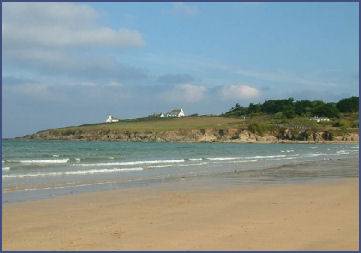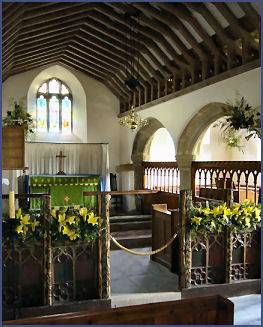Trebetherick
OS Grid ref:-SW931772
 The village of Trebetherick lies on the North Cornish coast midway between the villages of Rock and Polzeath.
The village of Trebetherick lies on the North Cornish coast midway between the villages of Rock and Polzeath.
Daymer Bay Beach, which lies on the north side of the Camel Estuary, has recently been voted one of the top ten beaches in the world and presents an excellent location for all standards of windsurfers. The sheltered beach is bordered by dunes and sandhills and has a large car park and beach shop/cafe which also provides windsurfing equipment.
Trebetherick stretches from Trebetherick Point southwards towards Rock. Trebetherick Point, which is owned by the National Tust, is a cliff outcrop which separates Daymer Bay from Hayle Bay, to the south. The ghostly remains of past shipwrecks are still visible on the jagged rocks below the point. The Poet Laureate John Betjeman, who had a life long love of Cornwall, particularly North Cornwall, wrote many poems about the surrounding area, including Greenaway, the stretch of coast with a small beach between Hayle Bay and Trebetherick Point. To the south of Daymer Bay stands Brea Hill, which is notable for its ancient tumuli.
Facilities in the village, a mainly residential area, include shops, hotels, pubs, a post office and an excellent golf course.
The church of St. Endonoc- burial place of John Betjemen
The characterful and ancient village church of St. Enodoc, a former chapel-of-ease, is situated in the sand dunes to the south of Trebetherick, the church is but a short walk from Daymer Bay across St. Enodoc Golf Course. John Betjemen lived locally and is buried in the churchyard, an ornate slate headstone marks the poet's final resting place. He died at his home in Trebetherick on 19th May, 1984. The church, a Grade I Listed building, dates from the twelfth century.
 The building is reputed to occupy the site of a cave where St. Enodoc once lived as a hermit, he is said to have baptised converts to Christianity at the nearby Jesus Well, a holy well which is located around half a mile away, the well house is a Grade II Listed Building.
The building is reputed to occupy the site of a cave where St. Enodoc once lived as a hermit, he is said to have baptised converts to Christianity at the nearby Jesus Well, a holy well which is located around half a mile away, the well house is a Grade II Listed Building.
Additions were made to the church in the thirteenth and fifteenth centuries. St Enodoc's had been partly covered by shifting sands by the eighteenth century, the sand being almost level with the roof on two sides, the building had to be entered by means of a hole in the north transept roof. The sand was removed in the nineteenth century when the church was restored between 1863-4 by the architect J. P. St Aubyn under the direction of the vicar, the Rev. Hart Smith. John Betjeman made reference to the church in his poem 'Sunday Afternoon Service at St. Enodoc'. A first-hand account of the restoration, dated 1919-21 and in the handwriting of the Rev. Hart Smith's son, has recently been unearthed:-.
"...... the sands had blown higher than the eastern gable, the wet came in freely, the high pews were mouldy-green and worm-eaten and bats flew about, living in the belfry. The communion table had two short legs to allow for the rock projecting at the foot of the east wall. When the building was restored, the walls were partly rebuilt, on good foundations, the sand removed and the little churchyard cleared and fenced with a stout wall. The roof was renewed and new seats provided. It all cost about £650 and I remember the pains and energy my father spent to raise the money. These works were done by the masons and workmen of the parish with loving care and nothing was destroyed needlessly or removed if it was of use or interest."
The rood screen in the church dates from the Medieval era while the Cornish granite font is of twelfth century origin. John Betjemen's father, Ernest Edward Betjemen, is honoured with a memorial tablet in the south wall of the nave, while the poet's mother is also buried in the churchyard, her grave is situated near the west boundary wall.